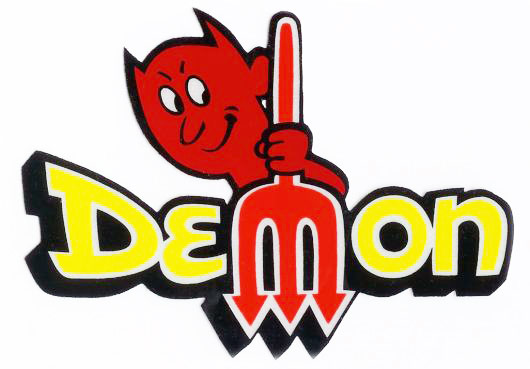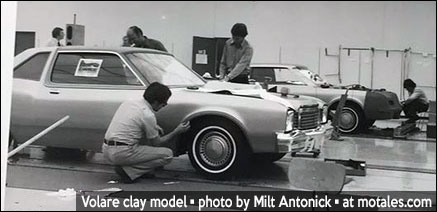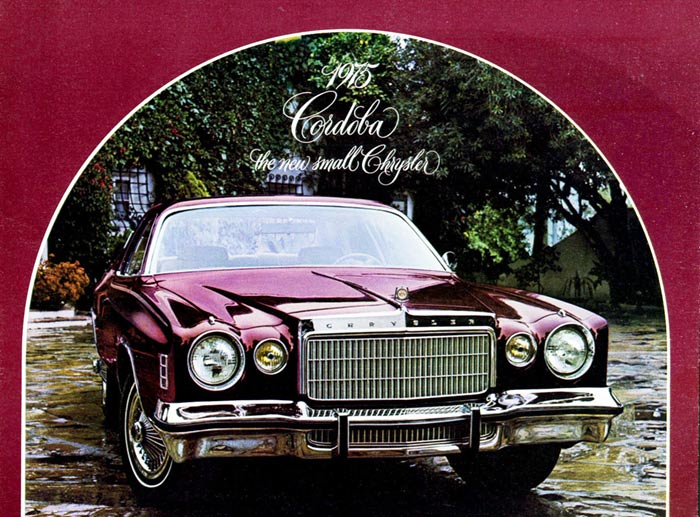Cars have been named by product planners, ad agencies, and others. Often, if a name is planned in advance, it used to be registered with an agency that reserved it so companies wouldn’t find each other scrapping over names — or wasting time and money creating nameplates and ad campaigns for a car or truck only to find someone else had gotten there first.
Product planner Burton Bouwkamp wrote that , “The Dodge Demon was named by the Dodge sales department because they envisioned an ad that said ‘Come in for a Demon-stration.’ The Demon name didn’t last because some religious groups formally objected to the Demon name.”

There are a few stories of the naming of the Valiant, including a contest for customers. Al Bosley, in charge of body engineering at the time, recalled that the Plymouth chief Alan J. Loofbourrow’s secretary, who he later married, submitted the Valiant name in a national naming contest which was open to everyone. According to Bosley:
She told me that she knew about the contest, but wasn’t planning to enter. She was reading the Sunday comics, saw Prince Valiant, made a connection with what a valiant person is, and thought it would be a great name and turned it in.
The car was originally to be its own division, but ended up as a Plymouth when it became clear that competing with the new Valiant would all but destroy Plymouth otherwise.
The Plymouth Volare and Dodge Aspen were meant to be the right cars for the time. Replacing the still-popular Valiant and Dart (“which were best-in-class when launched, probably still best-in-class when cancelled, but definitely feeling the years,” according to product planner Burt Bouwkamp), the Volare was clearly superior in ride, interior noise, and a driver-oriented dashboard. Its integrated air conditioning was one visible advantage over the Valiant’s afterthought bolt-on setup. It looked more upscale than the Valiant, at a time when buyers of pricier cars were moving to compacts to avoid fuel lines.

Design started in 1973, at the time of the first gas crisis; naming started in 1974. Burt Bouwkamp wrote:
During product development, the in-house code names for the “F” Body vehicles were Aspen (Dodge) and Vail (Plymouth). We had to call them something, so we called them Aspen and Vail; we, the product planners, just picked the names out of the air.
[When naming came up,] We thought new names were needed to communicate to the customer that these were new cars.
Len Piconke (Director of Marketing) and I (Director of Product Planning) kept Dodge Aspen. My recommendation for the Plymouth was either Cygnate or Signet. Our boss, George Butts, approved our proposal and arranged for a meeting with R. K. Brown (Executive VP of Sales) for his approval.
After hearing our proposal, R.K. said he would rather not have a new car at all then have it be named Cygnet (little swan) or Signet (precious stone). Later, I realized that the high-line Valiant was called the Signet, so to R.J., “Signet” was old.
George, Len, and I returned to George’s office. George, a new VP, was crushed because he thought the proposal would be “rubber stamped.”
Sitting in George’s office waiting for his next meeting was Norm Christy, our international product planner. George couldn’t stop talking about the disastrous meeting. Norm listened politely and said, “Why don’t you call it Volare?” We all asked what that meant, and Norm answered “it’s Italian for ‘to fly’.”
Len and I thought that was a good name and I suggested that we go back to R.K.’s office and propose it. George said, “No – if we go back to R.K. now he won’t think we have given it much thought.” (He was right!)
The next day, R.K.’s reaction was “I’ll bounce it off the ad agency.” The rest of the story is that the Plymouth ad agency loved it! They visualized an Italian singer like Jerry Vale, Al Martino, or Sergio Franchi being the spokesman, in song, for the new Plymouth Volare. They had the whole ad in their mind, so it became Volare — not Signet. We registered the Volare name and it was ours.
The Road Runner naming story has been told many times by the car’s creator, Jack Smith. He wanted a car that would look like most others, and be sold at a low price, but have unusually good performance, with suspension, brake, transmission, and engine choices that make it a track or street contender that was still affordable.

His first thought was to call it the C.K., for Clark Kent; hit the gas and the mild-mannered reporter turns into a true muscle car. The ad agency, since Man of La Mancha was a hit on Broadway, came back with La Mancha. Smith suggested a name originally thought up by Gordon Cherry—Road Runner—thinking of the fast bird that constantly infuriated a coyote. He asked if the advertising men watched cartoons on television, then suggested the name:
There was absolute silence at the table.... The young man from the art department was at the other end of the table with his head in his arms. He was thinking. ... and his body began to convulsively shake. He got our attention for fifteen to twenty seconds—that’s a long time for a table to be quiet... Suddenly his hands came down and he sat up and he said, “God! I could really do a lot with that!”
There is much more to this story.
Some names were chosen to portray an image, usually of wealth. That would include the Chrysler Fifth Avenue (a street known for its expensive shops), New Yorker (when they were thought to be sophisticated), Newport (vacation spot of the wealthy, though it grew less exclusive after the name was first used), and probably Cordoba. Arguably the monarchy names, e.g. Kingsway, Royal Imperial, and such, would fit there. Aspen was a ski area then associated somewhat with the wealthy as well. Other such names are in the Streets and Hotels section.

A somewhat different emotional association explained Durango, Rebel, and Challenger.
Daytona and Sebring were taken from raceways—Dodge Daytona may have been taken indirectly, via Dodge Charger Daytona.
Some cars had aspirational names—Valiant to compete against the flood of imports that was then just a trickle; Reliant to try to regain some aura of reliability after the Volare/Aspen; and of course Champ.
The first Chrysler, Dodge, and Plymouth cars were named simply (e.g. Chrysler 80, Plymouth Deluxe); but each marque was a single car with numerous bodies. One exception was the Chrysler Imperial. The Airflow models were called “Airflow,” admittedly, and were followed by the more conventionally styled Airstream series. Finally, in 1938, Chrysler started a modern naming system with the Imperial, Custom Imperial, New York Special (later “New Yorker”), and Royal—possibly influenced by a pending 1939 royal tour, assuming they knew of it that far in advance. In England, the Royal was replaced by the Kew and Wimbledon.

As Bill Watson pointed out, Chrysler names were clearly “royal.” Indeed, the 1939 Windsor was sadly not named for their Canadian headquarters and factory; it was technically the Royal Windsor, named for King George’s family. (The name may have been promoted by King George and Queen Elizabeth’s 1939 tour of the United States; during this tour, they were driven in a 1939 Imperial.) Badges would later become more “royal” as well; the 1951 Dodge ornament certainly tried to be aristocratic.
Plymouth’s first modern name was the 1939 Roadking but that model stood alone, joined by generic Deluxe and Special Deluxe type names. Dodge switched from these generic names with the 1949 Wayfarer, Coronet, and Meadowbrook—the latter named after the Dodge Brothers’ mansion. A coronet is a small crown; and Wayfarer was exported as the Kingsway. The cars did not change, only the names.

Two years later, Plymouth followed with the 1951 Savoy, Cambridge, Concord, and Cranbrook. Famed Plymouth historian Lanny Knutson pointed out that Cranbrook Drive, Concord Street, and Cambridge Avenue were all in the same suburban area. The Cranbrook School in Bloomfield Hills was a private school which hosted many executives’ children, and its school for girls, Kingswood, got its own model later. The Belvedere name also launched in 1951 for a Cranbrook trim level (it became a full model with the 1954s), likely named for the nearby golf course.

Hotels inspired the later Plymouth Plaza and Savoy, and eventually the Dodge St. Regis. The Dodge might, actually, have been named after the Studebaker St. Regis, but that was a long time before. In the 1960s, the naming routine was made rather more purposeful, though stories such as the naming of the Volare, Valiant, and Road Runner point that it has never been an exact science.
Largely from the Plymouth Owners Club, Jim Benjaminson, J.P. Joans, and Allpar.
Do you have a story? Let us know!
Copyright © 2021-2025 Zatz LLC • Chrysler / Mopar car stories and history.
YouTube • Editorial Guidelines • Videos
Tailfins Archive • MoTales on BlueSky